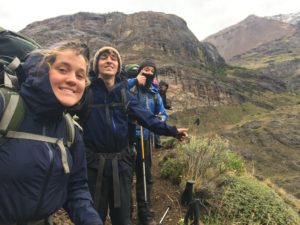Exploring Parque Nacional Patagonia
Students return from Chilean expeditions today more buff and in-balance than before. Our first few weeks have been a whirlwind and we are ready for beds and showers after more than two weeks of backcountry travel and camping in Parque Nacional Patagonia.
The two routes students backpacked were neighboring out-and-back trails, Sendero Furioso and Sendero Aviles, in the Cochrane region. Cochrane sits at approximately the 47th southern parallel and 700 feet in elevation amid the Chacabuco river valley and is surrounded by impressive peaks.

Students were asked to reflect on spending time together in this magnificent space, particularly in terms of the notable strides of ecological conservation work that made our journey here possible. In fact, Patagonia Park was designated in the early 2000s. What is more, Patagonia National Park was recently donated by its previous private owners, U.S. power couple Kris and Doug Thompkins, to the Chilean government. The park is now managed by the Chilean National Forestry Service. Prior to the transfer in ownership, the Thompkins had worked to purchase a number of land parcels in the region from local ranchers. They hoped to mitigate the harmful effects of overgrazing in the region, and by 2005…
Tompkins Conservation had bought another large parcel of land, a 764,000-acre sheep farm in Valle Chacabuco, which it named Patagonia Park. Local ranchers and farmers objected to the purchase, saying their traditional livelihoods were being disrupted.
With the help of international donors and partners, the group took down more than 400 miles of fencing, removed 25,000 sheep and again built high-end lodges, campgrounds, hiking trails and roads, developing programs to restore natural ecosystems and to reintroduce wildlife to their natural habitats.

As for Alzar School students, it is not unheard of for a crew of two to run into Kris hiking through the region! Although the creation of the park has been controversial for some, undeniable evidence stood out to us, as we hiked across the ridgelines and peered down into a valley, that the region is beginning to recover from grazing over the course of the previous century.
For more information, check out the following sources:
https://www.theguardian.com/travel/2015/nov/02/parque-patagonia-chile-new-national-park
https://www.nytimes.com/2018/02/19/world/americas/patagonia-national-park-chile.html
http://www.parquepatagonia.org/sp/index.htm
http://www.tompkinsconservation.com/home.htm
http://www.conaf.cl/parques/parque-nacional-torres-del-paine/
http://www.tierraspatagonicas.com/en/indigenous-peoples-of-patagonia-i/
https://www.theguardian.com/world/2018/mar/21/kingdom-mapuche-chile-patagonia-araucania

